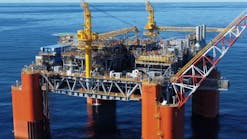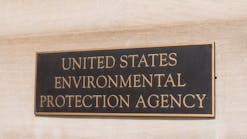Jim HowesThe Southeast Asia-Australasia region has over 100 productive petroleum systems ranging in age from the Paleozoic to the Pliocene.
Atlantic Richfield Indonesia Inc.
Jakarta
Plate tectonics have played a fundamental role in controlling the distribution and character of the region's petroleum systems. There is a clear division between those systems on the Eurasian plate and those on the Indo-Australian plate.
The distribution of significant oil and gas resources is highly concentrated in just a few chrono-stratigraphic units. Early Tertiary Paleogene source rocks account for over 50% of the region's in-place petroleum resources.
This article summarizes the region's systems and resources, and compares and contrasts some of their essential elements in Southeast Asia and Australasia.
Petroleum systems in Southeast Asia are dominated by Tertiary-aged systems, while those in Australasia are mainly of Mesozoic age (Fig 1 [111,602 bytes] and Fig 2 [47,985 bytes]).
Regional production
With average production of 3.2 million b/d of oil and 18 bscfd of gas, the region accounts for almost 6% of world oil and gas production. Production is dominated by Indonesia with around 1.5 million b/d of oil and 8 bscfd of gas, followed by Malaysia and Australia (Fig. 3 [46,600 bytes]). About half the gas produced is exported as liquefied natural gas (LNG) from the four principal gas producers: Indonesia, Malaysia, Australia, and Brunei. Indonesia alone currently accounts for half of the region's oil production and over half of its LNG exports.All countries in the region with the exception of Cambodia, Laos, and Singapore have established petroleum production; Cambodia has a number of recent offshore discoveries yet to be developed, and exploration in Laos is in progress. Singapore is considered nonprospective.
Oil, gas resources
The region covers 10% of the earth's continental crust and contains around 4% of the world's petroleum. Total discovered in-place resources amount to around 300 billion bbl of oil equivalent, of which 125 billion BOE (50 billion bbl of oil and condensate and 450 tcf of gas) are estimated to be recoverable under current conditions. Over 2,100 hydrocarbon accumulations have been found, including 50 giant oil and gas fields (estimated ultimate recovery each 500 MMBOE).Seventy-five percent of the region's resources lie in Tertiary systems on the Eurasian plate; the remaining 25% lie in Paleozoic through Eocene strata on the Indo-Australian plate. Estimates using typical ranges of migration and trapping efficiencies indicate that up to 50 trillion BOE of oil and gas may have been released from the region's source rocks since the early Mesozoic.
Plate tectonics
Basin architecture and source rock development of the region's petroleum systems have been strongly controlled by major lithospheric plate interaction.The majority of Southeast Asian petroleum systems have a Paleogene source and can be linked with early to mid Tertiary extrusion tectonics, intra-cratonic rifting, and back-arc extension associated with convergence of the Indo-Australian and Eurasian plates, and the India-Eurasia collision that began in the Eocene. A significant group of younger Southeast Asian Neogene deltaic petroleum systems occupy more of a passive margin setting around the island of Borneo. These are linked with the creation of significant accommodation space in the Makassar Straits, Celebes, Sulu, and South China Seas, coupled with major uplift in central Borneo.
In contrast, most Australian-New Guinea-New Zealand petroleum systems are related to the progressive counter-clockwise Late Paleozoic-Mesozoic rifting of the Australian continental margin, associated with the breakup of Gondwanaland. Some areas (e.g. Timor-Seram, Papua New Guinea, New Zealand) have been later modified by folding and thrusting related to more recent convergent plate tectonics and collisions.
Petroleum systems
Magoon and Dow's petroleum system definition1 refers to a volume of rock containing a single mature source pod and all related petroleum accumulations.Using this definition, there are over 100 and probably up to 250 proven productive petroleum systems in the region, with at least an equal number of speculative systems yet to be definitively explored. Scaling this up, it is interesting to note that there may be somewhere between 2,000 and 10,000 petroleum systems worldwide.
Many systems referred to in this article may be thought of as "composite" systems where multiple genetically and stratigraphically related petroleum source pods occur within a distinct geographical area. Good examples of composite systems are the Central Sumatra:Pematang-Sihapas (.) system, and the W Natuna system, both of which have multiple source pods of similar stratigraphic age.
The chrono-stratigraphic distribution of the region's petroleum systems is shown in Fig. 4 [77,877 bytes], and data on the top 25 systems ranked by recoverable BOE are shown in Table 1 [56,637 bytes]. Some essential elements of the region's petroleum systems are discussed below and illustrated in Figs. 5 to 8.
Source type
Non-marine source rocks account for 75% of trapped petroleum in the region (Fig. 5 [26,266 bytes]). Petroleum resources have come from three basic depositional settings: mixed oil and gas prone fluvio-deltaic sources (40%), oil-prone lacustrine sources (35%), and mixed oil and gas prone marine sources (25%). Coals have sourced more than 15% of in-place oil and gas in the region.Fluvio-deltaic sourced systems account for around 120 billion BOE in-place and 50 billion BOE recoverable oil and gas. Almost 50% of these reserves are attributable to two classic Neogene deltaic petroleum systems on the margins of Borneo, the Baram delta and the Kutei-Mahakam delta. Charge comes from several different facies within deltaic systems, including proximal oil-prone coals and more distal clastics containing finely dispersed organic matter. Deltaic-sourced systems appear generally more oil-prone than those with fully marine sources.
Coals in the region are considered responsible for sourcing 40 billion BOE of in-place oil and condensate, as well as 30 tcf of gas. The most prolific petroleum system associated with a coal source is probably the Late Cretaceous to Eocene Gippsland:Latrobe system in Southeast Australia (20 billion BOE). The counterpart to the Latrobe system is the Taranaki system across the Tasman Sea in New Zealand, also primarily coal-sourced (2.6 billion BOE) and of similar age. Older Permian coals provide the source for both gas and liquids in the Cooper, Eromanga, and Surat-Bowen systems (3 billion BOE in-place). On the Eurasian plate, younger Oligocene-aged oil-prone coals are important source rocks in South Sumatra and NW Java, associated with up to 20 billion BOE in place. Neogene coals are reported as the dominant source in the Kutei and Tarakan deltaic systems of Borneo (25 billion BOE).
Lacustrine sourced systems contain 100 billion BOE or one-third of in-place petroleum discovered to date in the region (Fig. 5). Almost all of this resource lies on the Eurasian plate. Classic syn-rift lacustrine-sourced systems include Central Sumatra (50 billion BOE), the Sunda basin off South Sumatra, the Cuu Long (Mekong) system in southern Viet Nam, and the Phitsanulok system onshore Thailand. Only minor lacustrine-sourced systems occur in Australasia (e.g. Eromanga, Otway).
Marine source rocks account for 80 billion BOE of in-place resources and dominate Australasian Early Paleozoic and Triassic through Early Cretaceous petroleum systems, including most Jurassic systems on the Northwest Shelf of Australia and the northern margin of the Australian plate through Irian Jaya and Papua New Guinea. In Southeast Asia many of the major Miocene-aged carbonate bioherm gas plays are sourced by either overmature marine shales (North Sumatra-Arun field) or marine carbonates (Central Luconia, Northwest Palawan.) Oil-prone systems with a marine carbonate source include Salawati (Miocene), Seram (Jurassic), and the Buton asphalts (Triassic). Marine shales are involved in bacterially generated (biogenic) gas in a number of systems, including the Gulf of Papua and the Northwest Java Parigi-Cisubuh systems. Both systems produce from Miocene-aged bioherms and have modest in-place gas resources of around 250 million BOE each.
Source age
The majority of petroleum resources in the region (55%) are associated with source rocks of Paleogene age (160 BOE in-place and 60 billion BOE reserves discovered to date). Syn-rift source rocks of Late Eocene to Oligocene age account for the majority of this resource base (Fig. 6 [20,152 bytes]). Neogene sources account for nearly 25% of in-place resources, followed by Mesozoic source rocks with around 20%. Paleozoic source rocks contribute only 2% to discovered resources.Almost all Tertiary sourced systems lie on the Eurasian plate. With the exception of the Khorat plateau onshore Thailand, all of the region's Paleozoic and Mesozoic systems, including four Late Triassic-Jurassic systems in Eastern Indonesia (Buton, Sula, Seram, and Bintuni) lie either directly on the Indo-Australian plate or have close affinity to it.
Reservoir type
Reservoirs include weathered basement, alluvial fans, lacustrine, fluvial-deltaic, paralic, and marine sandstones, turbidites, carbonate bioherms, calcarenites, and less conventional fractured volcanics, volcaniclastics, and hydrothermally altered granites.Sandstone reservoirs host over 85% of the petroleum discovered to date in the region, while carbonate reservoirs host 10-15%. Igneous reservoirs account for 2% of petroleum resources (Fig. 7 [20,754 bytes]). The two most significant igneous reservoirs occur in the Cuu Long (Mekong) system offshore Viet Nam (fractured hydrothermally altered Cretaceous granites, (1 billion BOE EUR) and the Jatibarang system of Northwest Java (fractured Eocene volcanics).
At least 10 petroleum systems rely on Miocene carbonate bioherms as both reservoir and trap. Around 30 billion BOE is reservoired in carbonate bioherms, of which 20 billion BOE is recoverable; 90%, or 100 tcf, of this resource is gas. Significant gas-prone systems include those in East Natuna, North Sumatra, Central Luconia, and Northwest Palawan. The only significant oil-prone system reservoired exclusively in carbonate bioherms is the Salawati system in Irian Jaya (EUR of 400 million BOE and 1 tcf gas). the majority of petroleum liquids recovered from the region's carbonate bioherms comes from gas-condensate reservoirs.
reservoir age
while the majority of source rocks are of paleogene age, nearly 50% of reservoirs are neogene in age (fig. 8 [18,039 bytes]). this reflects the predominance of vertically drained petroleum systems dominated by tertiary extensional tectonics, with upward migration of oil and gas occurring from paleogene source pods into overlying neogene reservoirs. paleogene reservoirs still account for around 35% of in-place resources, derived from both paleogene and underlying late cretaceous sources, the latter being important in the gippsland and taranaki systems on the australian plate. mesozoic reservoirs account for about 15% of in-place petroleum, and paleozoic reservoirs roughly match paleozoic source contributions at 2%.traps
trap styles in the region include simple anticlines, faulted four-way closures, tilted and rotated fault blocks, drape anticlines, large inverted "Sunda" folds (sumatra and the west natuna sea), complex growth anticlines (baram delta), and overthrust traps (seram island in indonesia, fold and thrust belt of papua new guinea, and the taranaki system of new zealand). structural traps predominate, though about 10% of the region's resources are stratigraphically trapped in miocene-aged carbonate bioherms. paleo-geomorphic traps ("buried hills") are also present in some areas.seals
seals are generally mudstones; evaporites do not play an important role in the region's petroleum systems. intra-formational seals are very common in southeast asian systems with multiple reservoirs and stacked hydrocarbon columns often present.migration style
many systems in the region are vertically drained, reflecting both the extensional tectonic style and the absence of world-class evaporite super-seals. distances of secondary and tertiary migration are often modest, usually less than 30 km.Pore Fluids
Most formation waters in southeast asia-australasia are fresh and brackish to moderately saline (around seawater composition). the absence of evaporites in almost all the region's petroleum systems means that highly saline formation waters are seldom encountered.carbon dioxide occurs as a gas contaminant in many of the region's petroleum systems, including north sumatra, south sumatra, northwest java, east natuna, central luconia, nam con son, song ho, otway, and taranaki systems. of particular interest is supergiant natuna gas field, which has over 200 tcf gas in place, around 70% of which (150 tcf) is carbon dioxide.
Hydrocarbon type
Based on ultimate BOE reserves, most of the region's major petroleum systems appear gas prone, with the exception of Central Sumatra, South Sumatra, and Gippsland, which are all strongly influenced by oil-prone lacustrine and/or oil-prone coal sources.Based on trapped fluids (in-place resources), about half of the larger petroleum systems in the region (Central Sumatra, Baram, Malay, Gippsland, South Sumatra, Burma, Ardjuna, Carnarvon) are slightly to strongly oil-prone in the subsurface, with the other half (Rankin, East Natuna, Central Luconia, North Sumatra, Browse, and Pattani) being strongly gas-prone. Kutei is a mixed system with a roughly 50-50 split between liquids and gas.
Most lacustrine-sourced systems appear strongly oil-prone, coal-sourced systems are moderately oil-prone, while a larger spread, including both oil-prone and gas-prone systems, is provided by deltaic and marine source rocks. Dry-gas systems are associated with biogenic-marine sources or very high thermogenic maturities.
Formation pressures
Most petroleum systems in the region exhibit normal hydrostatic gradients, at least at shallow to moderate depths. Excess formation pressures due to both compaction disequilibria and petroleum generation have been described from a number of systems including the major Neogene deltaic systems marginal to Borneo.Overpressure in these settings is usually associated with under-compaction, sand-deficient deltaic environments, and pro-delta mudstones.
Discovery process
A discovery process chart for the region shows the typical "creaming curve" associated with discovery of large structures and major resources early in the exploration process (Fig. 9 [66,784 bytes]).Clearly seen is the current predominance of gas over oil and condensate, both in terms of ultimate recovery and reserve addition rate. The current gas discovery rate is running at over 10 tcf/year, while liquids discovery has remained constant at around 650 million bbl/year the past 20 years-a rate that is well under the current production level of 1,150 million bbl/year.
Exploration performance peaked in the mid-1960s to mid-1970s and reached a low point in 1986 (based on mean field size curve). Since 1986, there appears to be a consistent trend of increasing mean field size and improved exploration performance.
Analysis of other data suggests that while many petroleum systems in the region are at a mature phase of exploration, about one-third of productive systems are under-explored, and many significant exploration opportunities remain.
Acknowledgments
Permission to publish this article was granted by Atlantic Richfield Indonesia Inc. and ARCO International Oil & Gas Co. Petroconsultants SA is gratefully acknowledged for use of their Worldwide Exploration and Production Database and Foreign Scouting Service Reports.Reference
- Magoon, L.B., and Dow, W.G., The petroleum system, in Magoon, L.B., and Dow W.G., editors, 1994, The petroleum system from source to trap, AAPG Memoir 60, 1994, pp. 3-24.
Based on a paper by the author titled "Petroleum Resources and Petroleum Systems of Southeast Asia, Australia, Papua New Guinea, and New Zealand," published in the proceedings of the Indonesian Petroleum Association Conference on Petroleum Systems of Southeast Asia and Australasia, Jakarta, May 1997.EURR = estimated ultimate recoverable resources (discovered to date). 1 BOE = I bbl oil, 1 bbl condensate, or 6 Mcf gas at standard conditions. Liquids % on BOE basis. SSIn place BOE from EURR assuming generic recovery efficiency of 25% for oil and 75% for gas. paragraphGiant fields: EURR 500 MMBOE. Reserve statistics modified from Petroconsultants Worlwide Exploration & Production Database. Petroleum systems compilation by author.
The Author
Jim Howes is a geological specialist in Jakarta with ARCO Indonesia. Previous positions with ARCO International in the U.S. include exploration director Southeast Asia-Australasia and exploration team leader Algeria and North Africa. He has 25 years' experience in oil and gas exploration worldwide, including the North Sea, North Africa, Asia, Australia, New Zealand, and Texas, where he worked as an independent for 5 years. He has an MA degree in geology from Cambridge University and an MSc degree in petroleum geology from Imperial College, London University. E-mail: [email protected]
Copyright 1997 Oil & Gas Journal. All Rights Reserved.



